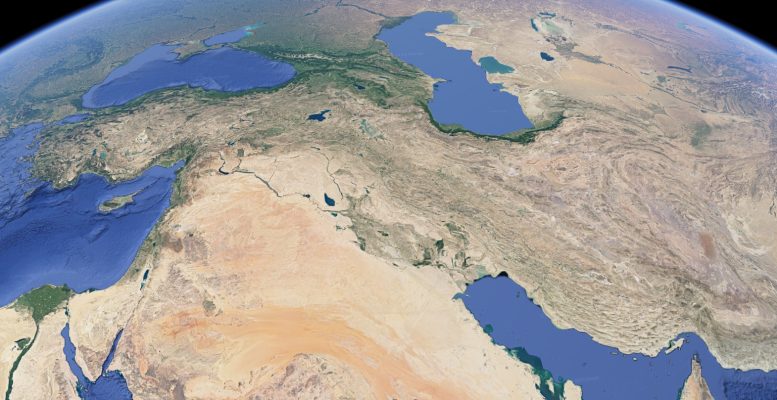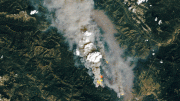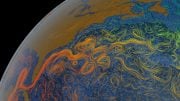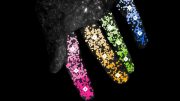
Persian Plateau, the most likely place where the ancestors of all present-day non-Africans lived for the 20.000 years that followed their migration Out of Africa. A period during which they also mixed their genes with the ones of the Neanderthals. Credit: authors of the original publication
All modern non-African human groups originated from ancestors who migrated out of Africa over 60,000 years ago. How long did it take for these separations to take place? Almost 20,000 years, during which they were all part of a single population. Where did they live for all this time? Scientists don’t know, yet.
This is a conversation that could have taken place one year ago, now it is possible to give clearer answers to these questions thanks to the study recently published in Nature Communications led by researchers from the University of Padova, in collaboration with the University of Bologna (Department of Cultural Heritage), the Griffith University of Brisbane, the Max Planck Institute of Jena and the University of Turin.
Out of Africa: The Journey Begins
The ancestors of all present-day Eurasians, Americans, and Oceanians, moved Out of Africa between 70 and 60 thousand years ago. After reaching Eurasia these early settlers idled for some millennia as a homogeneous population, in a presumably localized area, before expanding their range across the whole continent and beyond. This event set the basis for the genetic divergence between present-day Europeans and East Asians and can be dated to around 45 thousand years ago.
On the one hand, the dynamics that led to the broader colonization of Eurasia have been already reconstructed by some of the authors in a previous publication in 2022, and occurred through a series of chronologically, genetically, and culturally distinct expansions. On the other hand, the geographic area where the ancestors of all non-Africans lived after the Out of Africa and that acted as a “Hub” for the subsequent movements of Homo sapiens has been the matter of a long-standing debate, with most of West Asia, North Africa, South Asia or even South East Asia having been listed as potentially suitable locations.
Identifying the Hub of Early Human Migration
In their latest work, the authors deployed a novel genetic approach and identified ancient and modern populations from the Persian Plateau as the ones carrying genetic traces that most closely resemble the features of the Hub population, pinpointing the area as the likely homeland of all early Eurasians. “The most difficult part,” says Leonardo Vallini, first author of the study, “has been to disentangle the various confounding factors constituted by 45 thousand years of population movements and admixtures that took place after the Hub was settled.”
The multidisciplinary study also investigated the paleoecological characteristics of the area at the time and confirmed it as suitable for human occupation, potentially capable of sustaining a larger population than other parts of West Asia. “Identifying the Persian Plateau as a Hub for early human migration opens new doors for archaeological and palaeoanthropological research,” added co-author Professor Michael Petraglia of Griffith University in Brisbane.
In fact, the Persian plateau will be the focus of the ERC Synergy Project ‘LAST NEANDERTHALS’, recently awarded to co-author Stefano Benazzi, professor at the University of Bologna (Department of Cultural Heritage). “In line with the results of the study,” says Benazzi, “this ERC project aims to explore and unravel the intricate biocultural events that occurred between 60,000 and 40,000 years ago, focusing also on the Persian Plateau.”
“With our work, we found a home to 20,000 years of shared history between Europeans, East Asians, Native Americans, and Oceanians. This leg of the human journey out of Africa is fascinating since it is the one where we also met and mixed our genes with the ones of Neanderthals,” concluded Professor Luca Pagani, senior author of the study.
Reference: “The Persian plateau served as hub for Homo sapiens after the main out of Africa dispersal” by Leonardo Vallini, Carlo Zampieri, Mohamed Javad Shoaee, Eugenio Bortolini, Giulia Marciani, Serena Aneli, Telmo Pievani, Stefano Benazzi, Alberto Barausse, Massimo Mezzavilla, Michael D. Petraglia and Luca Pagani, 25 March 2024, Nature Communications.
DOI: 10.1038/s41467-024-46161-7









This illogical opening sentence sets the tone for this bizarre article: “All modern non-African human groups originated from ancestors who migrated out of Africa over 60,000 years ago.”
If these White people being forced out of bIack africa began breeding with Neanderthals who were obviously already established in Europe – where did the Neanderthals come from, Newark? Lastly, several inches above this article is another piece extolling the skills of 300,000 old hunters carving sticks.
So, is it 60,000 or 300,000? Come on Scitechdaily!!
I agree with Schaeffer’s comments. Further, it is well known / posited that there was more than one migration out of Africa. And finally, since a recent study from Oxford demonstrated that humans were in the Americas at least 30,000 years ago, how is it possible that they migrated from Africa, stopped in the Persian region for 20,000 years, and it only took them 10,000 years to migrate all the way across the Asian continent and over the Bering Sea (or by boat along the coasts, and further down the Americas. In addition, humans were in Australia about 47,000 years ago, so apparently they didn’t stop over in Persia.
All this says is the study needs adult supervision, or everyone else is wrong.